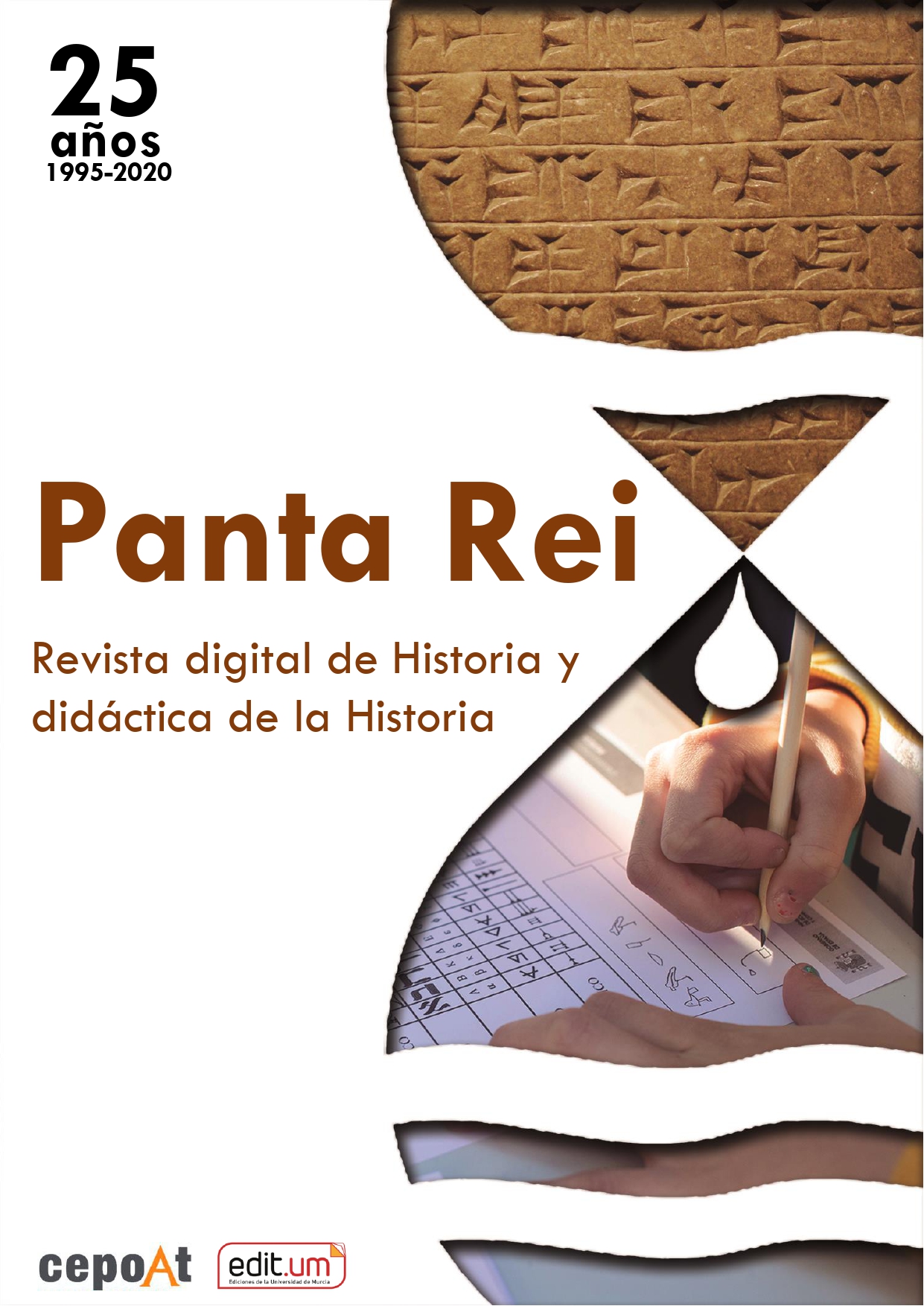La Historia social aplicada a la antigua Mesopotamia: cambios historiográficos y nuevas vías de investigación
Agencias de apoyo
- Contratos Ramón y Cajal (ref. RYC-2013-13617). Ministerio de Economía y Competitividad del Gobierno de España
Resumen
La presente contribución pretende revisar de qué manera la Historia Social, entendida como corriente historiográfica, ha penetrado en el mundo de los estudios cuneiformes y en la Historia de Mesopotamia. De esta manera, se ha realizado una exhaustiva revisión de la bibliografía disponible, sobre todo la referida a los veinticinco últimos años. El resultado principal es que esta tendencia historiográfica ha sido fructífera para el estudio del mundo cuneiforme, si bien dependiendo de periodos y temas ha tenido desigual fortuna. Además, se proporciona una visión (personal) de las líneas de investigación que, en el futuro, podrían seguir desarrollándose en el marco de la Historia Social de la antigua Mesopotamia.
Descargas
-
Resumen2066
-
PDF971
-
EPUB248
Citas
Adams, R. M. (1982). Property Rights and Functional Tenure in Mesopotamian Rural Communities. En M. A. Dandamaev, J. N. Postgate y M. T. Larsen (eds.), Societies and Languages of the Ancient Near East. Studies in Honour of I. M. Diakonoff (pp. 1-14). Warmister: Aris & Phillips.
Adams, R. M. (1984). Mesopotamian Social Evolution: Old Outlooks, New Goals. En T. Earle (ed.), On the Evolution of Complex Societies: Essays in Honor of Harry Hoijer 1982 (pp. 79-129). Malibu: Undena.
Alföldy, G. (1987). Historia social de Roma. Madrid: Alianza.
Alstola, T. (2020). Judeans in Babylonia. A Study of Deportees in the Sixth and Fifth Centuries BCE. Leiden/Boston: Brill.
Asher-Greve, J. (2002). Women and Gender in Ancient Near Eastern Cultures. Bibliography 1885 to 2001 AD. NIN. Journal of Gender Studies in Antiquity, 3, 33-114.
Avdiev, V. I. (1986). Historia económica y social del Antiguo Oriente. II. Reinos y Estados del II y I milenios. Madrid: Akal.
Bahrani, Z. (2001). Women of Babylon. Gender and Representation in Mesopotamia. London/New York: Routledge.
Bertman, S. (2003). Handbook to Life in Ancient Mesopotamia. New York: Oxford University Press.
Bordreuil, P., Briquel-Chatonnet, F. y Michel, C. (eds.). (2008). Les débuts de l’histoire. Le Proche-Orient, de l’invention de l’écriture à la naissance du monothéisme. Paris: Éditions de la Martinière.
Bottéro, J. (ed.) (1996). Introducción al antiguo Oriente. De Sumer a la Biblia. Barcelona: Grijalbo Mondadori.
Budin, S. L., Cifarelli, M., Garcia-Ventura, A. y Millet Albà, A. (eds.). (2018). Gender and Methodology in the Ancient Near East. Approaches from Assyriology and Beyond. Barcelona: Universitat de Barcelona.
Budin, S. L. y MacInstosh Turfa, J. (eds.). (2016). Women in Antiquity. Real Women across the Ancient World. London/New York: Routledge.
Cardellini, I. (1981). Die Biblischen “Sklaven”-Gesetze im Lichte des keilschriftlichen Sklavenrechts. Ein Beitrag zur Tradition, Überlieferung und Redaktion der alttestamentlichen Rechtstexte. Königstein: Hanstein.
Caro Baroja, J. (1970). Inquisición, brujería y criptojudaísmo. Barcelona: Ariel.
Casanova, J. (1991). La Historia Social y los historiadores. ¿Cenicienta o princesa? Barcelona: Crítica.
Casanova, J. (1996). Historia social/sociología histórica: un encuentro sin fusión. Ayer, 22, 105-110.
Chavalas, M. W. (ed.) (2014). Women in the Ancient Near East. London/New York: Routledge.
Chirichigno, G. C. (1993). Debt-Slavery in Israel and the Ancient Near East. Sheffield: Sheffield Academic Press.
Conesa Navarro, P. D., Gualda Bernal, R. M. y Martínez García, J. J. (eds.). (2019). Género y mujeres en el Mediterráneo antiguo. Iconografías y literaturas. Murcia: Universidad de Murcia.
Culbertson, L. (2011). Slaves and Households in the Near East. En L. Culbertson (ed.), Slaves and Households in the Near East (pp. 1-17). Chicago: The Oriental Institute of the University of Chicago.
Dandamaev, M. A. (1984). Slavery in Babylonia from Nabopolassar to Alexander the Great (626-331 BC). DeKalb: Northern Illinois University Press.
Di Bennardis, C. (2013). La centralización del poder político y el estado en las sociedades antiguo-orientales: reflexiones sobre teorías e interpretaciones. En C. Di Bennardis, E. Ravenna y I. Milevski (eds.), Diversidad de formaciones políticas en Mesopotamia y el Cercano Oriente (pp. 15-41). Barcelona: Universitat de Barcelona.
Dosch, G. (2009). Zur Struktur der Gesellschaft des Königsreichs Arrapḫe. Texte über die Streitwagenfahrer (rākib narkabti). Studies on the Civilization and Culture of Nuzi and the Hurrians, 18, 71-228.
Durand, J. M. y Reculeau, H. (2008). Tell Hariri / Mari: Textes. V. Environnement et occupation de l’espace. Supplément au Dictionnaire de la Bible, 14, 298-356.
Fleming, D. E. (2004). Democracy’s Ancient Ancestors: Mari and Early Collective Governance. Cambridge: Cambridge University Press.
Flynn, S. W. (ed.) (2019). Children in the Bible and the Ancient World. Comparative and Historical Methods in Reading Ancient Children. London/New York: Routledge.
Garcia-Ventura, A. (2016). Investigación feminista, Historia de las Mujeres y mujeres en los estudios sobre Próximo Oriente Antiguo. Revista de Estudos Culturais, 3. Recuperado de http://www.revistas.usp.br/revistaec/article/view/149562, último acceso 31/12/2019.
Garcia-Ventura, A. y Zisa, G. (2017). Gender and Women in Ancient Near Eastern Studies: Bibliography 2002-2016. Akkadica, 138, 37-67.
Garroway, K. H. (2014a). Children in the Ancient Near Eastern Household. Winona Lake: Eisenbrauns.
Garroway, K. H. (2014b). Neither Slave Nor Free: Children Living on the Edge of a Social Status. En B. T. Arnold, N. L. Erickson y J. H. Walton (eds.), Windows to the Ancient World of the Hebrew Bible. Essays in Honor of Samuel Greengus (pp. 121-137). Winona Lake: Eisenbrauns.
Gelb, I. J. (1973). Prisoners of War in Ancient Mesopotamia. Journal of Near Eastern Studies, 32, 70-98.
Gelb, I. J. (1979). Definition and Discussion of Slavery and Freedom. Ugarit-Forschungen, 11, 283-297.
Gelb, I. J. (1982). Terms for Slaves in Ancient Mesopotamia. En M. A. Dandamaev, J. N. Postgate y M. T. Larsen (eds.), Societies and Languages of the Ancient Near East. Studies in Honour of I. M. Diakonoff (pp. 81-98). Warmister: Aris & Phillips.
Gschnitzer, F. (1987). Historia social de Grecia. Desde el Periodo Micénico hasta el final de la Época Clásica. Madrid: Akal.
Harris, R. (1975). Ancient Sippar. A Demographic Study of an Old-Babylonian City (1894-1595 B.C.). Istanbul: Nederlands Historisch-Archaeologisch Instituut te Istanbul.
Justel, D. (2017). Infancia y legalidad en el Próximo Oriente antiguo durante el Bronce Reciente (ca. 1500-1100 a. C.). Atlanta: Society of Biblical Literature.
Justel, J. J. (2011). Mujeres y género en la historiografía del Próximo Oriente Antiguo: pasado, presente y futuro de la investigación. Arenal. Revista de Historia de las mujeres, 18, 371-407.
Justel, J. J. (2014). Mujeres y derecho en el Próximo Oriente Antiguo. La presencia de mujeres en los textos jurídicos cuneiformes del segundo y primer milenios a. C. Zaragoza: Pórtico.
Justel, J. J. (2017). Blindness in Nuzi Texts. Die Welt des Orients, 47, 242-258.
Justel, J. J. y Garcia-Ventura, A. (eds.). (2018). Las mujeres en el Oriente cuneiforme. Alcalá de Henares: Universidad de Alcalá.
Kärger, B. (2014). Leben in der amurritischen Welt. Nomaden und Sesshafte im Reich von Mari im 19. und 18. Jahrhundert vor Christus. Wiesbaden: Harrassowitz.
Klengel, H. (ed.) (1971). Beiträge zur sozialen Struktur des alten Vorderasien. Berlin: Akademie Verlag.
Klíma, J. (1980). Sociedad y cultura en la antigua Mesopotamia. Madrid: Akal.
Koliński, R. (2001). Mesopotamian dimātu of the Second Millennium BC. Oxford: Archaeopress.
Korostovtsev, M. A. (1977). Was ist ein Sklave? Altorientalische Forschungen, 5, 5-15.
Kraus, F. R. (1958). Ein Edikt des Königs Ammi-ṣaduqa von Babylon. Leiden: Brill.
Laes, C., Goodey, C. F. y Rose, M. L. (eds.). (2013). Dissabilities in Roman Antiquity: Disparate Bodies A Capite ad Calcem. Leiden/Boston: Brill.
Lion, B., y Michel, C. (eds.). (2016). The Role of Women in Work and Society in the Ancient Near East. Boston/Berlin: Walter de Gruyter.
Liverani, M. (1995). El antiguo Oriente. Historia, sociedad y economía. Barcelona: Crítica.
Liverani, M. (2003). Relaciones internacionales en el Próximo Oriente Antiguo, 1600-1100 a.C. Barcelona: Bellaterra.
Liverani, M. (2005). Más allá de la Biblia. Historia antigua de Israel. Barcelona: Crítica.
Lloyd, C. (1988). Explanation in Social History. Oxford/New York: Basil Blackwell.
Mendelsohn, I. (1949). Slavery in the Ancient Near East: A Comparative Study of Slavery in Babylonia, Assyria, Syria, and Palestine from the Middle of the Third Millenium to the End of the First Millenium. New York: Oxford University Press.
Molina, M. (2009-2011). Sklave, Sklaverei. A. Im 3. Jahrtausend. Reallexikon der Assyriologie und Vorderasiatischen Archäologie, 12, 562-564.
Moscati, S. (ed.) (1987). El alba de la civilización. Sociedad, economía y pensamiento en el Próximo Oriente Antiguo. Tomo I: La sociedad. Madrid: Ediciones Cristiandad.
Nemet-Nejat, K. R. (2002). Daily Life in Ancient Mesopotamia. Peabody: Greenwood.
Noiriel, G. (1989). Pour une approche subjectiviste du social. Annales. Économies, sociétés, civilisations, 6, 1435-1459.
Oppenheim, A. L. (2003). La antigua Mesopotamia. Retrato de una civilización extinguida (edición ampliada por Erica Reiner). Madrid: Gredos.
Porada, E., Hansen, D., Dunham, S. y Babcock, S. (1992). The Chronology of Mesopotamia ca. 7000-1600 BC. En R. Ehrich (ed.), Chronologies in Old World Archaeology: Third Edition (pp. 77-121). Chicago: The University of Chicago Press.
Postgate, J. N. (1999). La Mesopotamia arcaica. Sociedad y economía en el amanecer de la historia. Madrid: Akal.
Prentice, R. (2010). The Exchange of Goods and Services in Pre-Sargonic Lagash. Münster: Ugarit-Verlag.
Radner, K. (2009-2011). Sklave, Sklaverei. C. Neuassyrisch. Reallexikon der Assyriologie und Vorderasiatischen Archäologie, 12, 571-572.
Sasson, J. M. (ed.) (1995). Civilizations of the Ancient Near East. New York: Charles Scribner’s Sons.
Snell, D. C. (1997). Life in the Ancient Near East. New Haven: Yale University Press.
Snell, D. C. (2011). Slavery in the Ancient Near East. En K. Bradley y P. Cartledge (eds.), The Cambridge World History of Slavery. Volume 1: The Ancient Mediterranean World (pp. 4-21). Cambridge: Cambridge University Press.
Stol, M. (2004). Wirtschaft und Gesellschaft in altbabylonischer Zeit. En D. Charpin, D. O. Edzard y M. Stol (eds.), Mesopotamien. Die altbabylonische Zeit. Fribourg/Göttingen: Vandenhoeck & Ruprecht.
Stol, M. (2009-2011). Sklave, Sklaverei. B. Altbabylonisch. Reallexikon der Assyriologie und Vorderasiatischen Archäologie, 12, 564-571.
Stol, M. (2016). Women in the Ancient Near East. Boston/Berlin: Walter de Gruyter.
Stone, L. (1986). El pasado y el presente. Mexico: Fondo de Cultura Económica.
Szuchman, J. (ed.) (2009). Nomads, Tribes, and the State in the Ancient Near East. Cross-Disciplinary Perspectives. Chicago: The Oriental Institute of the University of Chicago.
Tenney, J. S. (2011a). Household Structure and Population Dynamics in the Middle Babylonian Provincial “Slave” Population. En L. Cutbertson (ed.), Slaves and Households in the Near East (pp. 135-146). Chicago: The Oriental Institute of the University of Chicago.
Tenney, J. S. (2011b). Life at the Bottom of Babylonian Society: Servile Laborers at Nippur in the 14th and 13th Centuries B.C. Leiden/Boston: Brill.
Trigger, B. G., Kemp, B. J., O’Connor, D. y Lloyd, A. B. (1985). Historia del Egipto Antiguo. Barcelona: Crítica.
Van de Mieroop, M. (1999). Cuneiform Texts and the Writing of History. London/New York: Routledge.
Van de Mieroop, M. (1999). The Government of an Ancient Mesopotamian City. En K. Watanabe (ed.), Priests and Officials in the Ancient Near East (pp. 139-161). Heidelberg: Universitätsverlag C. Winter.
Von Dassow, E. (2008). State and Society in the Late Bronze Age. Alalaḫ under the Mittani Empire. Bethesda: CDL Press.
Von Dassow, E. (2011). Freedom in Ancient Near Eastern Societies. En K. Radner y E. Robson (eds.), The Oxford Handbook of Cuneiform Culture (pp. 205-224). Oxford: Oxford University Press.
Von Dassow, E. (2014). Awīlum and Muškēnum in the Age of Hammurabi. En L. Marti (ed.), La famille dans le Proche-Orient ancien: réalités, symbolismes, et images (pp. 291-308). Winona Lake: Eisenbrauns.
Westbrook, R. (2003). Old Babylonian Period. En R. Westbrook (ed.), A History of Ancient Near Eastern Law (pp. 361-430). Leiden/Boston: Brill.
Wilhelm, G. (2009-2011). Sklave, Sklaverei. C. Bei den Hethitern. Reallexikon der Assyriologie und Vorderasiatischen Archäologie, 12, 574-576.
Williamson, J. G. (1990). La Cliometría: una visión norteamericana. Revista de Historia Económica - Journal of Iberian and Latin American Economic History, 8, 39-52.
Wunsch, C. (2009-2011). Sklave, Sklaverei. D. Neubabylonisch. Reallexikon der Assyriologie und Vorderasiatischen Archäologie, 12, 572-574.
Derechos de autor 2020 Josué Javier Justel Vicente

Esta obra está bajo una licencia internacional Creative Commons Atribución-CompartirIgual 4.0.
Todos los contenidos publicados en nuestra revista están sujetos a una licencia Atribución 4.0 Internacional (CC BY-SA 4.0) de Creative Commons. Usted es libre de compartir (copiar y redistribuir el material en cualquier medio o formato) y adaptar (remezclar, transformar y crear a partir del material para cualquier finalidad, incluso comercial), bajo los siguientes términos:
Reconocimiento: Debe reconocer adecuadamente la autoría, proporcionar un enlace a la licencia e indicar si se han realizado cambios. Puede hacerlo de cualquier manera razonable, pero no de una manera que sugiera que tiene el apoyo del licenciador o lo recibe por el uso que hace.
CompartirIgual: Si remezcla, transforma o crea a partir del material, deberá difundir sus contribuciones bajo la misma licencia que el original.
El texto completo de la licencia se puede consultar en: Licencia Creative Commons













